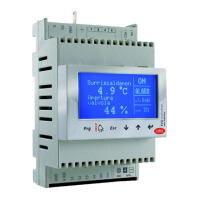30
ENG
“EVD evolution” +030222041 - rel. 1.0 - 01.06.2008
To reduce the condensing temperature, the output of the refrigeration
unit needs to be decreased. This can be done by controlled closing of
the electronic valve, implying superheat is no longer controlled, and
an increase in the superheat temperature. The protector will thus have
a moderate reaction that tends to limit the increase in the condensing
temperature, keeping it below the activation threshold while trying
to stop the superheat from increasing as much as possible. Normal
operating conditions will not resume based on the activation of the
protector, but rather on the reduction in the outside temperature. The
system will therefore remain in the best operating conditions (a little
below the threshold) until the environmental conditions change.
t
t
t
t
OFF
ON
ALARM
OFF
ON
PID
OFF
ON
HiTcond
T_COND_TH - ∆
T_COND_TH
T_COND
D
Fig. 7.d
Key:
T_COND Condensing temperature T_COND_
TH
HiTcond:
threshold
HiTcond HiTcond protection status ALARM Alarm
PID PID superheat control t Time
D Alarm delay
Note:
the HiTcond threshold must be greater than the rated condensing •
temperature of the unit and lower then the calibration of the high
pressure switch;
the closing of the valve will be limited if this causes an excessive •
decrease in the evaporation temperature.

